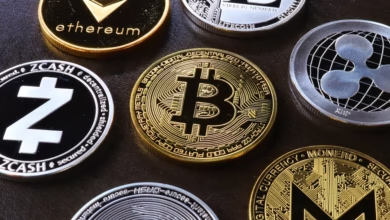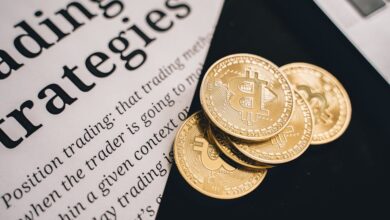Investing in Gold Coins and Collectibles: Navigating the Gold Market Trends and Future Opportunities

In an ever-evolving financial landscape, gold remains a shining beacon for investors seeking stability and security. As a safe haven asset, gold coins and collectibles present a compelling opportunity for those looking to diversify their portfolios and hedge against inflation. With the global gold demand on the rise, understanding the nuances of gold investment—particularly in rare and historical coins—can unlock significant potential for growth. This article will guide you through the essentials of investing in gold coins, exploring the dynamics of gold market trends and how fluctuations in gold prices can impact the value of your collectibles. Additionally, we will delve into the future of gold investment, examining the interplay between traditional gold assets and the burgeoning world of cryptocurrency. Whether you're a seasoned investor or new to the realm of gold, this comprehensive guide to gold coins and collectibles aims to illuminate the path to successful investing in this timeless asset.
- 1. Understanding Gold Coins and Collectibles: A Safe Haven Asset for Investors
- 2. Navigating the Gold Market Trends: How Gold Prices Affect Collectible Investments
- 3. The Future of Gold Investment: Analyzing Gold ETFs, Futures, and the Role of Gold in a Cryptocurrency World
1. Understanding Gold Coins and Collectibles: A Safe Haven Asset for Investors
Investing in gold coins and collectibles has emerged as an attractive option for those looking to diversify their portfolios and seek refuge from economic uncertainties. Understanding the nuances of gold as a safe haven asset is crucial for any investor. Historically, gold has maintained its value, making it a reliable investment during times of economic instability or inflation. As the global gold demand continues to rise, driven by factors such as central banks' gold reserves and the increasing interest in gold ETFs and gold futures, the market offers numerous opportunities for savvy investors.
Gold coins, particularly rare and historical pieces, are not merely numismatic treasures; they also represent a tangible form of gold investment. These coins can appreciate significantly over time, depending on their rarity, condition, and demand among collectors. Moreover, the luxury gold market is thriving, with collectors often willing to pay a premium for unique items that reflect history and craftsmanship.
In addition to their aesthetic and historical appeal, gold coins and collectibles provide a hedge against inflation. As inflation rises, the value of fiat currencies tends to decrease, while gold prices usually increase, reinforcing its status as a safe haven asset. This relationship is evident in current gold market trends, where many investors turn to physical gold as a safeguard for their wealth.
Investors should also consider the broader context of gold production and refining, as well as the ethical dimensions of sustainable gold mining. In recent years, concerns about gold smuggling and the environmental impact of gold mining have prompted a movement toward responsible sourcing and gold recycling. These trends not only affect the availability of gold but also influence gold market analysis and the overall perception of gold as an investment.
As the landscape of investments evolves, the relationship between gold and cryptocurrency also warrants attention. While some view cryptocurrencies as a modern alternative to gold, the enduring value of gold coins and collectibles remains unmatched. They serve as a bridge between traditional wealth preservation and contemporary investment strategies.
In conclusion, investing in gold coins and collectibles offers a unique combination of historical significance, aesthetic appeal, and financial security. By staying informed about gold market trends and understanding the factors that influence gold prices, investors can make educated decisions that align with their financial goals.
2. Navigating the Gold Market Trends: How Gold Prices Affect Collectible Investments
Understanding gold market trends is crucial for anyone considering an investment in rare and historical gold coins. The relationship between gold prices and collectible investments can heavily influence the potential returns on such investments. As gold is often viewed as a safe haven asset, its value tends to rise during times of economic uncertainty, which can impact the demand for gold coins and collectibles.
Historically, when gold prices increase, so does interest in physical gold, including rare coins. Investors often turn to gold coins as a hedge against inflation and economic instability, seeking to diversify their portfolios. This growing interest can lead to higher prices for gold collectibles, making it a potentially lucrative investment. In contrast, during periods of declining gold prices, the demand for collectible coins may wane, leading to a decrease in their market value.
Additionally, gold market analysis reveals that central banks play a significant role in gold prices. The accumulation of gold reserves by these institutions can signal to the market that gold is a reliable investment. Moreover, trends in gold production, mining, and refining practices also affect the supply chain, ultimately influencing gold prices.
Investors should also consider the impact of gold ETFs and futures on the market. These financial products can drive fluctuations in gold prices and affect the perceived value of gold collectibles. For example, an increase in gold ETF popularity could lead to increased demand for physical gold, including rare coins, thereby boosting their prices.
Finally, the rise of sustainable gold mining practices and concerns about gold smuggling can also impact the gold market. Ethical considerations are becoming more prominent among investors, and those seeking luxury gold items may prefer coins that are sourced responsibly. Understanding these trends is essential for anyone looking to navigate the complex landscape of gold coins investing.
In conclusion, keeping an eye on gold market trends is vital for making informed decisions in the world of gold collectibles. By understanding the dynamics of gold prices, investors can better assess the potential risks and rewards associated with their investments in rare and historical gold coins.
3. The Future of Gold Investment: Analyzing Gold ETFs, Futures, and the Role of Gold in a Cryptocurrency World
As we look to the future of gold investment, it is essential to analyze how various investment vehicles, such as gold ETFs and futures, play a role in shaping the gold market. The growing popularity of digital currencies raises questions about gold's position as a safe haven asset, especially in a world where cryptocurrency is gaining traction.
Gold ETFs (Exchange-Traded Funds) have become a popular choice for investors looking to gain exposure to gold without the need for physical gold storage. These funds track the price of gold and can be traded like stocks, providing liquidity and flexibility for investors. As gold market trends shift, the demand for gold ETFs is expected to rise, particularly during periods of economic uncertainty or inflation. The relationship between gold and inflation has historically been strong, making gold a preferred asset during inflationary times.
On the other hand, gold futures allow investors to speculate on the future price of gold, providing opportunities for profit in both rising and falling markets. This derivative market plays a significant role in gold market analysis, as it reflects investor sentiment and expectations regarding gold prices. As global gold demand fluctuates, understanding the dynamics of futures contracts becomes crucial for those involved in gold coins investing or trading.
In recent years, the interplay between gold and cryptocurrency has become increasingly significant. While cryptocurrencies offer a new investment avenue, many investors still view gold as a stable, tangible asset that can hedge against market volatility. Gold coins and collectibles continue to attract attention, especially among investors looking for both aesthetic value and historical significance. Central banks are also ramping up their gold reserves, reinforcing gold's position as a critical component of a diversified portfolio.
As we move forward, sustainable gold mining practices will likely gain importance, addressing environmental concerns while meeting global gold demand. Additionally, initiatives like gold recycling and refining can enhance the supply chain, promoting responsible gold production.
In summary, the future of gold investment lies at the intersection of traditional assets and emerging technologies. By understanding the roles of gold ETFs, futures, and the broader economic landscape, investors can make informed decisions while navigating the evolving relationship between gold and cryptocurrency. As the gold trade continues to adapt, the timeless allure of gold coins and collectibles remains a steadfast component of an investment strategy, ensuring that gold retains its place in both history and modern finance.
In conclusion, investing in rare and historical gold coins presents a unique opportunity for those looking to diversify their portfolios with a safe haven asset. As we have explored, understanding the dynamics of the gold market trends—such as fluctuations in gold prices and the influence of gold mining practices—can significantly impact the value of gold collectibles. Moreover, as we move towards a future where gold ETFs and gold futures become increasingly prominent, it is essential for investors to stay informed about the evolving landscape of gold investment, including the implications of gold and cryptocurrency interactions.
The enduring appeal of physical gold remains strong, bolstered by global gold demand and the historical significance of gold coins. As central banks continue to hold substantial gold reserves, the stability and intrinsic value of gold as a hedge against inflation are reaffirmed. Additionally, as we become more conscious of sustainable gold mining and the importance of ethical sourcing, investing in luxury gold and collectibles can align with broader values.
Ultimately, whether you are a seasoned collector or a new investor, the world of gold coins offers a fascinating blend of history, art, and financial opportunity. By conducting thorough gold market analysis and staying abreast of trends, from gold recycling to innovations in gold technology, you can make informed decisions that enhance your investment strategy. As the gold trade continues to evolve, embracing the timeless value of gold collectibles can provide both financial security and a tangible connection to the past.





